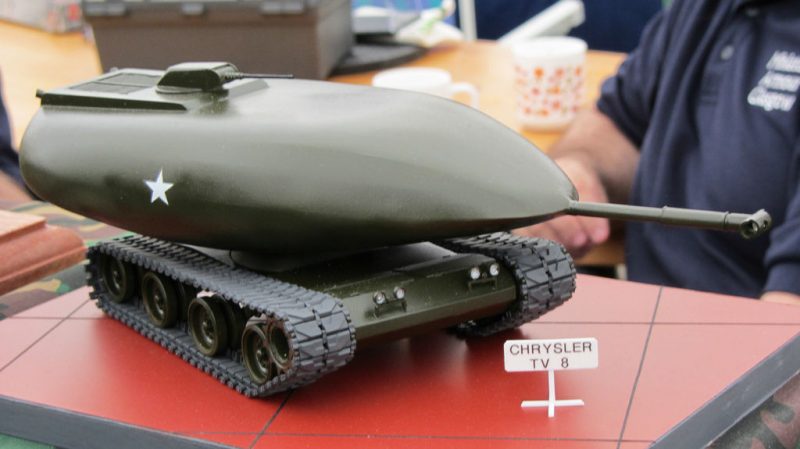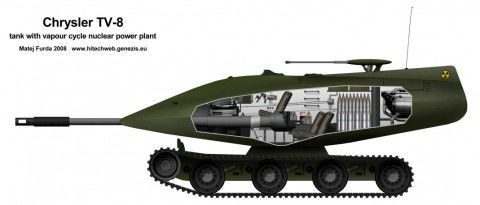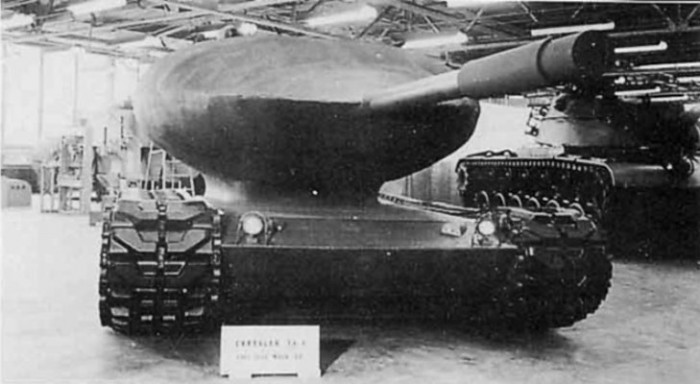The Chrysler TV-8 was an experimental concept tank designed by Chrysler in the 1950s. The tank was intended to be a nuclear-powered medium tank capable of land and amphibious warfare. The design was never mass-produced.
The 50’s were a time of ferment in the tank design business, what with all those nukes to contend with, concerns about the need to disperse formations, reduce the number of troops, make the vehicles lighter and more strategically deployable.
There have been many theoretical approaches for doing things differently than the classic 3 in the turret, one in the hull that is pretty standard (with some variations). Two of the more common variations are “all in the turret” and “all in the hull except the gun” approaches.

This design located the entire crew, armament, and power plant in that pod-shaped turret mounted above a very lightweight chassis. The total weight was estimated to be 25 tons with about 15 tons in the turret and 10 tons in the chassis.
The TV-8 was to be armed with the 90mm gun T208 that would be rigidly mounted in the turret and have an auto-rammer. Presaging the ammo storage designs of most modern tanks like the M1 and later model Leopards, the ammunition stowage was in the rear of the turret separated from the crew by a steel bulkhead.
Secondary armament consisted of two coaxial .30 caliber machine guns firing through the turret and one .50 caliber machine gun on top of the turret remotely operated by the tank commander. The crew would use closed circuit television to protect the crew from the flash of tactical nuclear weapons.
The phase I design of the Chrysler TV-8 featured a Chrysler V-8 engine with 300 gross horsepower which was coupled to an electric generator located within the rear turret; the generator powered two electric motors in the front hull, each motor driving either of the two 28-inch wide tracks.
Other methods of powering the tank that were later considered include a gas turbine engine drive, a vapour-cycle power plant fueled by hydrocarbons, and a nuclear fission-powered vapour-cycle power plant.
Interior layout of the Chrysler TV-8
Note there’s essentially a turret within the turret. Although the tank could be operated by only the gunner and driver, the tank was to have a crew of four – because a crew of four can be self-sufficient for numerous maintenance tasks like breaking track, while a crew of two is generally going to have no choice but to sit around and wait for help – a concern with some FCS platforms, like the NLOS-Cannon today.
The gunner and driver flanked the gun. The driver could operate fully protected inside the turret or with his head and shoulders exposed above the roof, though I’m still thinking this is a tank that would have taken out a lot of fences, cars, and building corners maneuvering through the villages that dot the german countryside.

The Chrysler TV-8 concept tank showing off it’s swimming ability. At least in an artist’s fantasy…
She was to be propelled like a personal watercraft is today – a jet pump operating from the turret. In a nod to not-yet-popular RPGs (but very popular HEAT rounds fired by cannon) the shell did double-duty, acting like the slat-armor on Strykers to pre-detonate shaped-charge warheads thus reducing their penetrative power.
The turret was supported by an articulated assembly which rotated in a ring in the hull roof and it was moved in elevation by two large hydraulic cylinders. I’m just guessing that the cynical engineers on the team called that the Achilles Assembly.
Further studies determined that this design offered no real advantages over the current (and still current) form of tank design, so nothing ever went beyond mock-up stage.


Δεν υπάρχουν σχόλια:
Δημοσίευση σχολίου